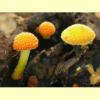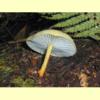
images/Cyptotrama_aspratum/Cyptotrama_aspratum.jpg
Small to medium agaric, growing on wood, with a white spore print. Pileus yellow to orange, rarely white, dry, with erect fibres that aggregate as tufts or pyramidal scales. Lamellae adnate or subdecurrent, rarely decurrent, white. Stipe central. Initially with cobwebby partial veil, but this soon disappearing and not leaving traces on stipe. Spores limoniform, hyaline, non-amyloid, smooth; germ pore absent. Cheilocystidia present. Lamellar trama interwoven or bilateral. Pileipellis a trichoderm or a hymeniderm. Clamp connections present.
Some
Armillaria species are yellow or orange-brown, but they are more robust and while they can have a rough pileus (like sandpaper), they do not have prominent scales.
Cystoderma has a yellow pileus with a granular surface and white lamellae, but it is terrestrial among moss. In
Amanita, some species have pyramidal warts, but members of this genus do not grow on wood, and usually have a distinct basal volva.
Cyptotrama Singer, Lilloa 30: 375 (1960).
One species: Cyptotrama aspratum.
Cyptotrama aspratum (Berk.) Redhead & Ginns, Canad. J. Bot. 58: 731 (1980).
S.A., Qld, N.S.W., Vic. and Tas. (and possibly also N.T.).
In native forests, usually in rather wet sites.
On dead wood or branches.
Saprotrophic.
Fuhrer, B. (2005),
A Field Guide to Australian Fungi. Bloomings Books, Hawthorn. [
Description and
Illustration of
C. aspratum]
Grey, P. & Grey, E. (2005), Fungi Down Under. Fungimap, South Yarra. [Description, Illustration and Map for C. aspratum]
Grgurinovic, C.A. (1997a), Larger Fungi of South Australia. The Botanic Gardens of Adelaide and State Herbarium and The Flora and Fauna of South Australia Handbooks Committee, Adelaide. [Description and Microcharacters of C. aspratum]
Härkönen, M., Niemelä, T. & Mwasumbi, L. (2003), Tanzanian mushrooms. Edible, harmful and other fungi, Norrlinia 10: 1–200. [Description, Illustration and Microcharacters of C. aspratum]
McCann, I.R. (2003), Australian Fungi Illustrated. Macdown Productions, Vermont. [Illustration of C. aspratum]
Pegler, D.N. (1997), The Larger Fungi of Borneo. Natural History Publications, Kota Kinabalu. [Illustration of C. aspratum]
Redhead, S.A. & Ginns, J.[H.] (1980), Cyptotrama asprata (Agaricales) from North America and notes on the five other species of Cyptotrama sect. Xerulina, Canad. J. Bot. 58: 731–740. [Description, B&W Illustration and Microcharacters of C. aspratum]
Young, A.M. (2005b), A Field Guide to the Fungi of Australia. University of New South Wales Press, Sydney. [Description and Illustration of C. aspratum]



_AM_17_sml.jpg)
